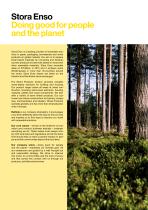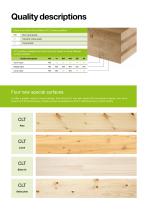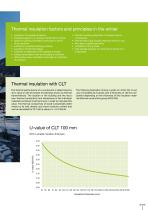
Catalog excerpts

Stora Enso CLT Technical brochure
Open the catalog to page 1
Stora Enso Doing good for people and the planet Stora Enso is a leading provider of renewable solutions in paper, packaging, biomaterials and wood products on global markets. Our aim is to replace fossil based materials by innovating and developing new products and services based on wood and other renewable materials. Stora Enso recorded sales of €10 billion in 2015 and it employs some 26,000 people in more than 35 countries around the world. Stora Enso shares are listed on the Helsinki and Stockholm stock exchanges. The Wood Products division provides versatile wood-based solutions for...
Open the catalog to page 2
Production widths: 245 cm, 275 cm, 295 cm Production lengths: from minimum production length of 8.00 m per charged width up to max. 16.00 m (in 10 cm increments) with C panels, the sanding direction is at right angles to the grain cover layers consisting of two lengthwise layers cover layers and inner layer consisting of two lengthwise layers
Open the catalog to page 5
Panel design CLT solid wood panels are made up of at least three layers of bonded single-layer panels arranged at right angles to one another. From five layers, CLT can also include middle layers (transverse layers) without narrow side bonding. It can currently be produced with dimensions of up to 2.95 × 16.00 m. Example: Design of a 5-layer CLT solid-wood panel narrow side bonding (lengthwise layers) flat dovetailing surface bond narrow side bonding * (transverse layers) * rom five layers, middle layers (transverse layers) can also be processed without narrow side
Open the catalog to page 6
Quality descriptions Stora Enso offers three different CLT surface qualities NVI Non-visual quality Industrial visible quality Visual quality CLT qualities available from Stora Enso are based on three different surface qualities Quality description Cover layer Middle layer Cover layer Four new special surfaces To offer a greater choice of wood species, Stora Enso CLT now also exists with the special surfaces: pine, larch, silver fir and Swiss stone pine. These surfaces are applied as a 20 mm additional layer in visible quality.
Open the catalog to page 8
2. Structure CLT elements have a wide range of applications. For example, when used on external, internal and partition walls, due to their structure which consists of bonded boards arranged at right angles to one another, they assume both a load-bearing and a bracing function in the building. Examples of design details and component designs Ceiling Ceiling joint (butt board) Ceiling Ceiling joint (stepped rebate) CLT ceiling board clearance joint-sealing tape edge board screw connection (according to structural analysis) CLT ceiling board clearance CLT ceiling board joint-sealing tape...
Open the catalog to page 10
The high level of prefabrication and related short assembly times are a major advantage, especially when CLT panels are used as roof elements, as buildings can be rendered rain-proof in short time scales. Thanks to CLT, roofs and ceilings can be economically designed with standard span lengths, and building requirements can be fully satisfied. With the right choice of structural components this can be easily achieved and, at the same time, CLT can be combined with virtually any type of construction material. Internal wall Facing panel (spring clips) Floor structure Wet screed insulation...
Open the catalog to page 11
3. Building physics Thermal insulation Introduction The notion “thermal insulation of buildings” covers all measures implemented to reduce heating requirements during ¹ the winter and cooling requirements in the summer. Thus ² the aim of thermal insulation is to keep energy consumption as low as possible while taking into account the functionality of different building components and their insulating properties, and at the same time ensuring comfort and creating a pleasant indoor atmosphere. ¹) Quantity of heat which must be supplied to the building during the course of one year in order...
Open the catalog to page 12
Thermal insulation factors and principles in the winter • avoidance of exposed locations • preference given to a compact construction method • optimum building orientation particularly in terms of the windows • sufficiently insulated building envelope • avoidance of thermal bridges • sufficient air-tightness of the building envelope • energy transmission level and shading of windows • total surface area, orientation and angle of inclination of windows • thermal insulating properties of opaque exterior components • internal heat loads (people, electrical devices, etc.) • floor plan or...
Open the catalog to page 13
Air-tightness An air- and wind-tight building envelope is an essential requirement for an energy-efficient building. An air-tight layer on the inside of the building prevents the penetration of damp air and subsequently the formation of condensation in components. This impacts the heat and humidity balance, and therefore the energy balance of buildings, and is critical to the quality and durability of the building’s structure. Inadequate air-tightness can mean that air flows through the structure from inside to outside. The wind-tightness of a building envelope is just as relevant as its...
Open the catalog to page 14
CLT also remains air-tight throughout its service life Throughout its service life, CLT is exposed to different moisture conditions. It is produced with a relative timber moisture content of 12% ± 2% depending on the surface quality. During the construction phase, it absorbs building moisture, for instance, from joint filler, screed or plaster, thus increasing the timber moisture content. The service life is also characterised by seasonal fluctuations in timber moisture content. Domestic ventilation can also dry out CLT during the winter months. These moisture content fluctuations of CLT...
Open the catalog to page 15
Moisture Introduction The aim of moisture protection is to limit the various effects of moisture on building constructions to such an extent that damage for example, reduction of thermal perfor— mance, loss of strength of building materials, mould and rot is prevented. The various effects of moisture include, — in particular, condensation, atmospheric moisture and rising damp. In addition, during the construction phase, increased moisture content of building materials can occur due to the absorption of building moisture from screed or plaster for example. CLT’s vapour diffusion...
Open the catalog to page 16All Stora Enso catalogs and technical brochures
-
Building Solutions
325 Pages
-
CLT by Stora Enso
20 Pages
-
CLT
24 Pages





